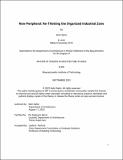Non-Peripheral: Re-Thinking the Organized Industrial Zone
Author(s)
Sahin, Selin
DownloadThesis PDF (3.730Mb)
Advisor
Barrio, Roi Salgueiro
Terms of use
Metadata
Show full item recordAbstract
The Organized Industrial Zone (OIZ) in Turkey emerged in the 1960s as a primary model for industrial development. Combining base infrastructure, specific land use rules, financial incentives
such as tax exemptions, and partial self-governance, the OIZ is essentially a cluster of light to medium industries. It was meant to facilitate capital flows and later became seen as a tool to
drive urbanization. This thesis examines the development, consequences, and future prospects of OIZs. It traces their origins from a Checci and Company report, based on the industrial estates, commissioned through an agreement between the governments of Turkey and the United States, to their rapid proliferation in the 21st century.
Today, there are over three hundred individual sites scattered across the country. Varying in size and complexity, these zones are born from policies and regulations that have barely changed
since the late 1960s. As the OIZ model stands today, both at the policy level and in practice, there is a multitude of issues related to their internal organization, urban planning, impacts on the environment, regional disparities, and social equity. In exploring the evolving relationships between OIZs and the urban texture, sped up by expanding boundaries and changing paradigms in the industry, I submit that the design of OIZs should not be peripheral in our thinking.
Selecting a particular site that is exemplary of the spatial conditions of many OIZs, I propose design interventions to address current problems and speculate the future of these zones. The components of the proposal factor in the city, within a material ecologies awareness. Through these proposals, this thesis aims to spatialize some of the hopes and narratives about these zones in the political consciousness and offer new urban visions.
Date issued
2023-09Department
Massachusetts Institute of Technology. Department of ArchitecturePublisher
Massachusetts Institute of Technology